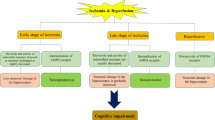Abstract
Nitric oxide has been implicated as a mediator of synaptic transmission and a pathological factor in stroke/reperfusion. The purpose of this study was to detect the change of nitric oxide concentration in rat hippocampus during global cerebral ischemia and reperfusion in vivo and to reveal effects of different nitric oxide synthases. In the present study, the real-time record of nitric oxide levels in rat hippocampus was obtained by using a nitric oxide sensor during global cerebral ischemia and the initial stage of reperfusion. We also observed the effects of two inhibitors of nitric oxide synthases on nitric oxide concentration. The two inhibitors were administrated intravenously at the onset of reperfusion and 1 h later. The change of the nitric oxide concentration in the initial stage of reperfusion was 0.768 ± 0.029 μM. 7-Nitroindazole (7-NI , inhibitor of nNOS) had a strong inhibitive effect on nitric oxide synthesis at both time points, while 1400 W dihydrochloride (1400 W, inhibitor of iNOS ) had no significant effect on nitric oxide synthesis. The results showed that during the initial stage of reperfusion, nitric oxide biosynthesis was mainly an nNOS-dependent process.
Access this chapter
Tax calculation will be finalised at checkout
Purchases are for personal use only
Similar content being viewed by others
References
Palmer, R. M., Ferrige, A. G., Moncada, S. (1987) Nitric oxide release accounts for the biological activity of endothelium-derived relaxing factor. Nature 327, 524–526.
Ignarro, L. J., Buga, G. M., Wood, K. S., Byrns, R. E., Chaudhuri, G. (1987) Endothelium-derived relaxing factor produced and released from artery and vein is nitric oxide. PNAS 84, 9265–9269.
Moncada, S., Bolanos, J. P. (2006) Nitric oxide, cell bioenergetics and neurodegeneration. J Neurochem 97, 1676–1689.
Choi, D. W. (1993) Nitric oxide: foe or friend to the injured brain? PNAS 90, 9741–9743.
Dawson, T. M., Snyder, S. H. (1994) Gases as biological messengers: nitric oxide and carbon monoxide in the brain. J Neurosci 14, 5147–5159.
Panahian, N., Yoshida, T., Huang, P., Hedley-Whyte, E., Dalkara, T., Fishman, M., Moskowitz, M. (1996) Attenuated hippocampal damage after global cerebral global ischemia in mice mutant in neuronal nitric oxide synthase. Neuroscience 72, 343–354.
Iadecola, C. (1997) Bright and dark sides of nitric oxide in ischemic brain injury. Trends Neurosci 20, 132–139.
Samdani, A. F., Dawson, T. M., Dawson, V. L. (1997) Nitric oxide synthase in models of focal global ischemia. Stroke 28, 1283–1288.
Adachi, N., Lei, B., Soutani, M., Arai, T. (2000) Different roles of neuronal and endothelial nitric oxide synthases on ischemic nitric oxide production in gerbil striatum. Neurosci Lett 288, 151–154.
Khoo, J., Alp, N., Bendall, J., Kawashima, S., Yokoyama, M., Zhang, Y., Casadei, B., Channon, K. (2004) EPR quantification of vascular nitric oxide production in genetically modified mouse models. Nitric Oxide 10, 156–161.
Shin, J., Schoenfisch, M. (2006) Improving the biocompatibility of in vivo sensors. Analyst 131, 609–615.
Neishi, Y., Mochizuki, S., Miyasaka, T., Kawamoto, T., Kume, T., Sukmawan, R., Tsukiji, M., Ogasawara, Y., Kajiya, F., Akasaka, T., Yoshida, K., Goto, M. (2005) Evaluation of bioavailability of nitric oxide in coronary circulation by direct measurement of plasma nitric oxide concentration. PNAS 102, 11456–11461.
Valtschanoff, J. G., Weinberg, R. J., Kharazia, V. N., Nakane, M., Schmidt, H. H. H. W. (1993) Neurons in rat hippocampus that synthesize nitric oxide. J Comp Neurol 331, 111–121.
Bredt, D. S., Hwang, P. M., Snyder, S. H. (1990) Localization of nitric oxide synthase indicating a neural role for nitric oxide. Nature 347, 768–770.
Liu, K., Ning, G., Zheng, X. (2005) In vivo detection of nitric oxide in rat hippocampus. In Proceedings of the 2005 IEEE Eng Med Biol 27th Annual Conference, September 1–4, 2005, Shanghai, China, pp. 1039–1042.
Zhang, X., Cardosa, L., Broderik, M., Hein, H. (1999) An integrated nitric oxide selective ultramicrosensor. Free Radic Biol Med 27, 89.
Zhang, X., Cardosa, L., Broderick, M., Fein, H., Davies, I. R. (2000) Novel calibration method for nitric oxide microsensors by stoichiometrical generation of nitric oxide from snap. Electroanalysis 12, 425–428.
Pulsinelli, W. A., Buchan, A. M. (1988) The four-vessel occlusion rat model: method for complete occlusion of vertebral arteries and control of collateral circulation. Stroke 19, 913–914.
Acknowledgement
This work was supported by Zhejiang Provincial Key Laboratory of Chinese Medicine Screening, Exploitation & Medicinal Effectiveness Appraise for Cardio-Cerebral Vascular & Nervous System.
Author information
Authors and Affiliations
Corresponding author
Editor information
Editors and Affiliations
Rights and permissions
Copyright information
© 2011 Springer Science+Business Media, LLC
About this protocol
Cite this protocol
Zheng, X., Liu, K., Yang, Y. (2011). Real-Time Measurement of Murine Hippocampus NO Levels in Response to Cerebral Ischemia/Reperfusion . In: McCarthy, H., Coulter, J. (eds) Nitric Oxide. Methods in Molecular Biology, vol 704. Humana Press. https://doi.org/10.1007/978-1-61737-964-2_6
Download citation
DOI: https://doi.org/10.1007/978-1-61737-964-2_6
Published:
Publisher Name: Humana Press
Print ISBN: 978-1-61737-963-5
Online ISBN: 978-1-61737-964-2
eBook Packages: Springer Protocols




